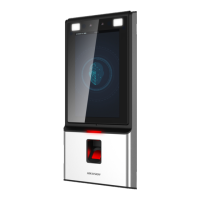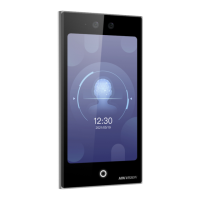Do you have a question about the HIKVISION DS-K1T642M and is the answer not in the manual?
Instructions for using the product and information on manual updates and website references.
Hikvision's trademarks and logos are its properties in various jurisdictions.
Outlines Hikvision's liability limitations and user responsibilities for product usage and security.
Details FCC compliance, limits for digital devices, and measures to correct interference.
States product compliance with EU harmonized standards marked with 'CE'.
Critical warnings that could cause serious injury or death if neglected.
Precautions that could cause injury or equipment damage if neglected.
Introduces the face recognition terminal as an access control device for various applications.
Lists key features including touch screen, recognition distance, capacity, and supported protocols.
Guidelines for optimal installation locations, light sources, and avoiding reflective objects.
Step-by-step instructions for securely mounting the device on a wall.
Details the function, color, and name of each terminal on the device.
Explains how to connect the terminal with standard peripherals for operation.
Illustrates wiring for connecting the terminal to a secure door control unit.
Wiring diagrams for fire module integration, covering power-off scenarios.
Guides on activating the device directly through its interface.
Explains the process of activating the device using a web browser.
Details activating the device using the SADP tool for detection and activation.
Describes activating the device through the client software interface.
Instructions for selecting the system language after device activation.
Setting password recovery options via email or security questions.
Explains how to select an application mode for optimal device performance.
Covers setting up wired or Wi-Fi network connections for the device.
Describes enabling communication with Hik-Connect for remote access and management.
Allows configuration of picture uploading and storage parameters for privacy.
Covers adding an administrator account for device management and configuration.
Details logging in via administrator credentials or the activation password.
Covers setting up network parameters, including wired, Wi-Fi, RS-485, and Wiegand.
Managing users, including adding administrators and other user roles.
Customizing face parameters for recognition performance, including liveness and distance.
Details setting access permissions, NFC card usage, door contact, and open time.
Explains how to log into the device using a web browser.
How to view the live video feed from the device through the web interface.
Adding and managing person information, including basic details, cards, and pictures.
Covers various device configurations, including local parameters, time, and maintenance.
A flow diagram illustrating the client software configuration process.
Managing access control and video intercom devices within the client software.
Managing person information, including adding organizations and configuring details.
Configuring holiday and week schedules for access authorization templates.
Creating access groups to define who can access which doors, and applying them to devices.
Configuring advanced access control functions for specific operational requirements.
Viewing and managing event information from devices in real-time and historically.
Functionalities for tracking and monitoring employee work hours and attendance.
Configuring system-wide settings like log expiry, network performance, and calendar type.
Performing maintenance operations like opening logs, import/export, backup, and skin changes.
Illustrates the correct way to place a finger on the scanner for successful recognition.
Specifies the optimal distance and positioning for collecting face pictures for recognition.
Advises on maintaining a natural expression and avoiding accessories during face capture.
Guides on maintaining correct posture and face alignment towards the camera for accurate capture.
Provides reference illumination values (Lux) for different light sources for installation planning.
Advises on avoiding specific lighting conditions to ensure optimal face recognition performance.
Provides QR code to access device communication matrix information.
Provides QR code to access common serial port commands for devices.
Instructions for using the product and information on manual updates and website references.
Hikvision's trademarks and logos are its properties in various jurisdictions.
Outlines Hikvision's liability limitations and user responsibilities for product usage and security.
Details FCC compliance, limits for digital devices, and measures to correct interference.
States product compliance with EU harmonized standards marked with 'CE'.
Critical warnings that could cause serious injury or death if neglected.
Precautions that could cause injury or equipment damage if neglected.
Introduces the face recognition terminal as an access control device for various applications.
Lists key features including touch screen, recognition distance, capacity, and supported protocols.
Guidelines for optimal installation locations, light sources, and avoiding reflective objects.
Step-by-step instructions for securely mounting the device on a wall.
Details the function, color, and name of each terminal on the device.
Explains how to connect the terminal with standard peripherals for operation.
Illustrates wiring for connecting the terminal to a secure door control unit.
Wiring diagrams for fire module integration, covering power-off scenarios.
Guides on activating the device directly through its interface.
Explains the process of activating the device using a web browser.
Details activating the device using the SADP tool for detection and activation.
Describes activating the device through the client software interface.
Instructions for selecting the system language after device activation.
Setting password recovery options via email or security questions.
Explains how to select an application mode for optimal device performance.
Covers setting up wired or Wi-Fi network connections for the device.
Describes enabling communication with Hik-Connect for remote access and management.
Allows configuration of picture uploading and storage parameters for privacy.
Covers adding an administrator account for device management and configuration.
Details logging in via administrator credentials or the activation password.
Covers setting up network parameters, including wired, Wi-Fi, RS-485, and Wiegand.
Managing users, including adding administrators and other user roles.
Customizing face parameters for recognition performance, including liveness and distance.
Details setting access permissions, NFC card usage, door contact, and open time.
Explains how to log into the device using a web browser.
How to view the live video feed from the device through the web interface.
Adding and managing person information, including basic details, cards, and pictures.
Covers various device configurations, including local parameters, time, and maintenance.
A flow diagram illustrating the client software configuration process.
Managing access control and video intercom devices within the client software.
Managing person information, including adding organizations and configuring details.
Configuring holiday and week schedules for access authorization templates.
Creating access groups to define who can access which doors, and applying them to devices.
Configuring advanced access control functions for specific operational requirements.
Viewing and managing event information from devices in real-time and historically.
Functionalities for tracking and monitoring employee work hours and attendance.
Configuring system-wide settings like log expiry, network performance, and calendar type.
Performing maintenance operations like opening logs, import/export, backup, and skin changes.
Illustrates the correct way to place a finger on the scanner for successful recognition.
Specifies the optimal distance and positioning for collecting face pictures for recognition.
Advises on maintaining a natural expression and avoiding accessories during face capture.
Guides on maintaining correct posture and face alignment towards the camera for accurate capture.
Provides reference illumination values (Lux) for different light sources for installation planning.
Advises on avoiding specific lighting conditions to ensure optimal face recognition performance.
Provides QR code to access device communication matrix information.
Provides QR code to access common serial port commands for devices.
| QR code | Yes |
|---|---|
| Product color | Black |
| Cards capacity | 10000 cards |
| RFID frequency | 13.56 MHz |
| Recommended usage | Indoor |
| Fingerprint reader | No |
| Authentication type | Access chip/card, Face recognition |
| Access chip/card reader type | Contactless |
| Display diagonal | 4.3 \ |
| Cabling technology | 10/100/1000 |
| Ethernet LAN (RJ-45) ports | 1 |
| Supported network protocols | TCP/IP, Ehome 5.0, ISAPI |
| Total megapixels | 2 MP |
| Front camera type | Dual camera |
| Operating temperature (T-T) | -10 - 50 °C |
| Operating relative humidity (H-H) | 0 - 90 % |
| Depth | 20 mm |
|---|---|
| Width | 118 mm |











